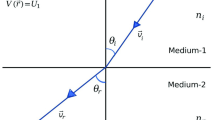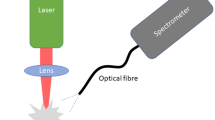Abstract
Distinctive oscillations in the diffraction line intensity were observed when a laser beam was directed at selected spots on single skeletal muscle fibres of frog and normally to the fibres. These intensity oscillations were interpreted as the diffraction from cylindrical myofibrils because they followed the first-order Bessel function. This interpretation allowed a direct determination of the myofibrillar diameter from the first intensity minimum of the zerothorder diffraction line. The hypothesis that the intensity oscillations were related to the myofibrillar diameter was substantiated by further experiments. At fixed sarcomere length the measured myofibrillar diameter increased when the fibre was immersed in hypotonic solution and decreased in hypertonic solution. In another experiment the diameter decreased and the sarcomere volume remained constant when the fibre was stretched passively. Furthermore, there was excellent agreement between the myofibrillar diameters measured by light diffractometry and electron microscopy.
Similar content being viewed by others
References
Bear RS, Bolduan OEA (1950) Diffraction by cylindircal bodies with periodic axial structure. Acta Cryst 3:236–241
Blinks JR (1965) Influence of osmotic strength on cross-section and volume of isolated singe muscle fibres. J Physiol (Lond) 177:42–57
Cleworth DR, Edman KAP (1972) Changes in sarcomere length during isometric tension development in frog skeletal muscle. J Physiol (Lond) 227:1–17
Edman KAP, Hwang JC (1977) The force-velocity relationship in vertebrate muscle fibres at varied tonicity of the extracellular medium. J Physiol 269:255–272
Fujime S, Yoshino S (1978) Optical diffraction study of muscle fibers. I. Theoretical basis. Biophys Chem 8:305–315
Hwang JC, Leung AF, Cheung YM (1981) Estimation of changes in single muscle fibre diameter in different solutions by diffraction studies. Pflügers Archiv 390:70–72
Kawai M, Kuntz JD (1973) Optical diffraction studies of muscle fibres. Biophys J 13:857–876
Leung AF (1982a) High-resolution laser diffraction spectra of striated muscle fibres. Biophys J 37:131a
Leung AF (1982b) Laser diffraction of single intact cardiac muscle cells at rest. J Muscle Res Cell Motil [in press]
Paolini PJ, Roos KP, Baskin RJ (1977) Light diffraction studies of sarcomere dynamics in single skeletal muscle fibres. Biophys J 20:221–232
Rudel R, Zite-Ferenczy F (1979) Interpretation of light diffraction by cross-striated muscle as Bragg reflexion of light by the lattice of contractile proteins. J Physiol (Lond) 290:317–330
Yeh Y, Baskin RJ, Lieber RL, Roos KP (1980) Theory of light diffraction by single skeletal muscle fibres. Biophys J 29:509–522
Author information
Authors and Affiliations
Rights and permissions
About this article
Cite this article
Leung, A.F., Hwang, J.C. & Cheung, Y.M. Determination of myofibrillar diameter by light diffractometry. Pflugers Arch. 396, 238–242 (1983). https://doi.org/10.1007/BF00587861
Received:
Accepted:
Issue Date:
DOI: https://doi.org/10.1007/BF00587861




